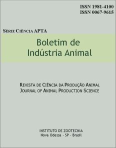Inbreeding and reproduction in the Mantiqueira cattle of the Estação Experimental de Zootecnia de Pindamonhangaba
Abstract
Data from a basic herd of Mantiqueira type cattle, raised at the €œEstação Experimental de Zootecnia de Pindamonhangaba€, over a 30 years period, since its formation in 1952 were studied. Some aspects of inbreeding of 443 cows born in the farm from over fíve generations by maternal line, daughters of 25 sires, were considered to study the age at first calving, calving interval, service period, gestation length and birth weight. The inbreeding coefficient estimated for the 443 cows was 2,88 ± 0,22%, beign the minimum value, 0.00 and the maximum, 28,32% and for the 25 sires was 1,74 %, with a minimum, 0,00 and the maximum of 14,65%. The effect of inbreeding, included in the model as a linear regression covariat was a significant source of variation for AFC, when studied both as a class interval (5%) or continuous variable. For each 5% increase, it was observed an increase of 60,50 days in the age at firts calving (y = 1175,32 ± 60,56x) and for each 1% increase (continuous variable), it was obtained an increase of 9,912 ± 2,76 days in the age of first calving. GL (y1) was significantly affected by class of inbreeding (x), (quadratic effect), presenting the following function: y1 =283,323 - 3,892x + 0,817x2. CI and BW were not significantly affected by inbreeding. Hertability estimates takino, into acount the inbreeding effects were not substantiality affected, since the values obtained for the inbreeding coefficientes were low. Although the inbreeding levels observed in the herd were low, it must be avoided for this type of cattle, because of its deleterious effects.Downloads
Downloads
Published
Issue
Section
License
Os autores não serão remunerados pela publicação de trabalhos, pois devem abrir mão de seus direitos autorais em favor deste periódico. Por outro lado, os autores ficam autorizados a publicar seus artigos, simultaneamente, em repositórios da instituição de sua origem, desde que citada a fonte da publicação original seja Boletim de Indústria Animal. A revista se reserva o direito de efetuar, nos originais, alterações de ordem normativa, ortográfica e gramatical, com vistas a manter o padrão culto da língua e a credibilidade do veículo. Respeitará, no entanto, o estilo de escrever dos autores. Alterações, correções ou sugestões de ordem conceitual serão encaminhadas aos autores, quando necessário. Nesses casos, os artigos, depois de adequados, deverão ser submetidos a nova apreciação. As opiniões emitidas pelos autores dos artigos são de sua exclusiva responsabilidade. Todo o conteúdo deste periódico, exceto onde está identificado, está licenciado sob a Licença Creative Commons Attribution (CC-BY-NC). A condição BY implica que os licenciados podem copiar, distribuir, exibir e executar a obra e fazer trabalhos derivados com base em que só se dão o autor ou licenciante os créditos na forma especificada por estes. A cláusula NC significa que os licenciados podem copiar, distribuir, exibir e executar a obra e fazer trabalhos derivados com base apenas para fins não comerciais.













